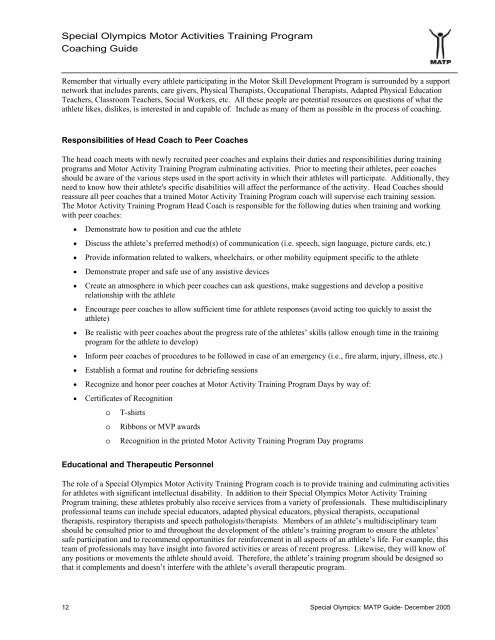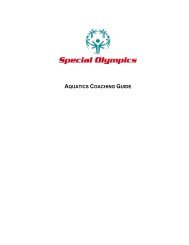MATP Coaching Guide - Special Olympics
MATP Coaching Guide - Special Olympics
MATP Coaching Guide - Special Olympics
You also want an ePaper? Increase the reach of your titles
YUMPU automatically turns print PDFs into web optimized ePapers that Google loves.
<strong>Special</strong> <strong>Olympics</strong> Motor Activities Training Program<br />
<strong>Coaching</strong> <strong>Guide</strong><br />
Remember that virtually every athlete participating in the Motor Skill Development Program is surrounded by a support<br />
network that includes parents, care givers, Physical Therapists, Occupational Therapists, Adapted Physical Education<br />
Teachers, Classroom Teachers, Social Workers, etc. All these people are potential resources on questions of what the<br />
athlete likes, dislikes, is interested in and capable of. Include as many of them as possible in the process of coaching.<br />
Responsibilities of Head Coach to Peer Coaches<br />
The head coach meets with newly recruited peer coaches and explains their duties and responsibilities during training<br />
programs and Motor Activity Training Program culminating activities. Prior to meeting their athletes, peer coaches<br />
should be aware of the various steps used in the sport activity in which their athletes will participate. Additionally, they<br />
need to know how their athlete's specific disabilities will affect the performance of the activity. Head Coaches should<br />
reassure all peer coaches that a trained Motor Activity Training Program coach will supervise each training session.<br />
The Motor Activity Training Program Head Coach is responsible for the following duties when training and working<br />
with peer coaches:<br />
Demonstrate how to position and cue the athlete<br />
Discuss the athlete s preferred method(s) of communication (i.e. speech, sign language, picture cards, etc.)<br />
Provide information related to walkers, wheelchairs, or other mobility equipment specific to the athlete<br />
Demonstrate proper and safe use of any assistive devices<br />
Create an atmosphere in which peer coaches can ask questions, make suggestions and develop a positive<br />
relationship with the athlete<br />
Encourage peer coaches to allow sufficient time for athlete responses (avoid acting too quickly to assist the<br />
athlete)<br />
Be realistic with peer coaches about the progress rate of the athletes skills (allow enough time in the training<br />
program for the athlete to develop)<br />
Inform peer coaches of procedures to be followed in case of an emergency (i.e., fire alarm, injury, illness, etc.)<br />
Establish a format and routine for debriefing sessions<br />
Recognize and honor peer coaches at Motor Activity Training Program Days by way of:<br />
Certificates of Recognition<br />
o T-shirts<br />
o Ribbons or MVP awards<br />
o Recognition in the printed Motor Activity Training Program Day programs<br />
Educational and Therapeutic Personnel<br />
The role of a <strong>Special</strong> <strong>Olympics</strong> Motor Activity Training Program coach is to provide training and culminating activities<br />
for athletes with significant intellectual disability. In addition to their <strong>Special</strong> <strong>Olympics</strong> Motor Activity Training<br />
Program training, these athletes probably also receive services from a variety of professionals. These multidisciplinary<br />
professional teams can include special educators, adapted physical educators, physical therapists, occupational<br />
therapists, respiratory therapists and speech pathologists/therapists. Members of an athlete s multidisciplinary team<br />
should be consulted prior to and throughout the development of the athlete s training program to ensure the athletes<br />
safe participation and to recommend opportunities for reinforcement in all aspects of an athlete s life. For example, this<br />
team of professionals may have insight into favored activities or areas of recent progress. Likewise, they will know of<br />
any positions or movements the athlete should avoid. Therefore, the athlete s training program should be designed so<br />
that it complements and doesn t interfere with the athlete s overall therapeutic program.<br />
12 <strong>Special</strong> <strong>Olympics</strong>: <strong>MATP</strong> <strong>Guide</strong>- December 2005
















